Why does travel always feel like a dream once it’s over? It took until we touched down on the tarmac at LAX for it to hit me: my short time in Rwanda — “The Heart of Africa” — had come and gone. The “pinch me” moments flooded my memory: sitting face to face with a family of mountain gorillas in the jungle, picking my way across a teetering suspension bridge over one of Africa’s oldest rainforests, watching lions prowl through tall grass in the savannah…
And now, just like that, I was some 10,000 miles away. The memories already fading, like I was viewing them through the mist at Volcanoes National Park.
Of the more than one million international tourists who visit Rwanda annually, almost 92% arrive with permits (or at least plans) to meet endangered mountain gorillas. These primates (with whom we share a staggering 98% of our DNA) are enjoying a population upswing — in large part thanks to Rwanda’s sustainable tourism infrastructure. But beyond this once-in-a-lifetime wildlife encounter, Rwanda’s unique artistic and cultural heritage is reason enough to visit the east-central African nation. Couple that culture with the sheer raw beauty of the land and the kindness tourists often report… Speaking personally, Rwanda is the most extraordinary place I’ve ever been.
If you’re dreaming of a life-changing trip and wish to encounter some of the world’s rarest animals, read our Rwanda guide, below.
PART I — Welcome to Rwanda
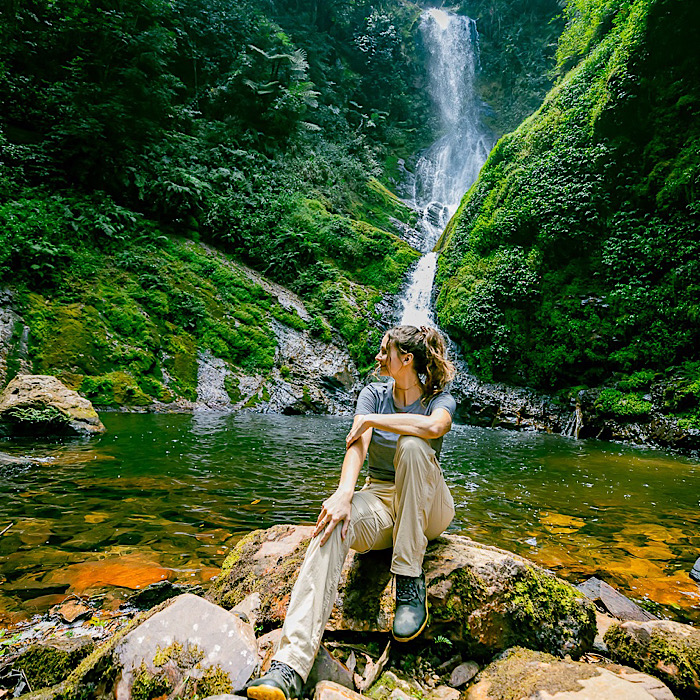
First, let’s talk money. Roundtrip flights from the U.S. to Rwanda start (conservatively) at $1k. For hikes, safaris, and primate treks, you’ll need national park entry, which averages around $75. Many also require a guide at an extra fee.
As for gorilla trekking permits, those are $1,500. If you’re picking up what I’m putting down, a trip to Rwanda won’t be cheap. These once-in-a-lifetime experiences come with a price tag. But your tourism dollars are an essential part of wildlife conservation and community upliftment projects. My gorilla trek, safaris, and hikes in Rwanda were all the more enjoyable knowing this.
As for accommodation, Rwanda boasts some of Africa’s most luxurious eco-lodges. But you can also visit on a moderate budget and stay in eco-villages or participate in voluntourism. Most hotels, restaurants, and tourist places in Rwanda take US dollars, but the national currency is the Rwandan Franc (RWF). The exchange rate is typically honored at $1USD to $1,000RWF (though, in reality, it fluctuates around $0.80USD to $1,000RWF).
You’ll want Rwandan Francs on hand for tipping, coffee runs, and roadside souvenir shops.
Getting Around
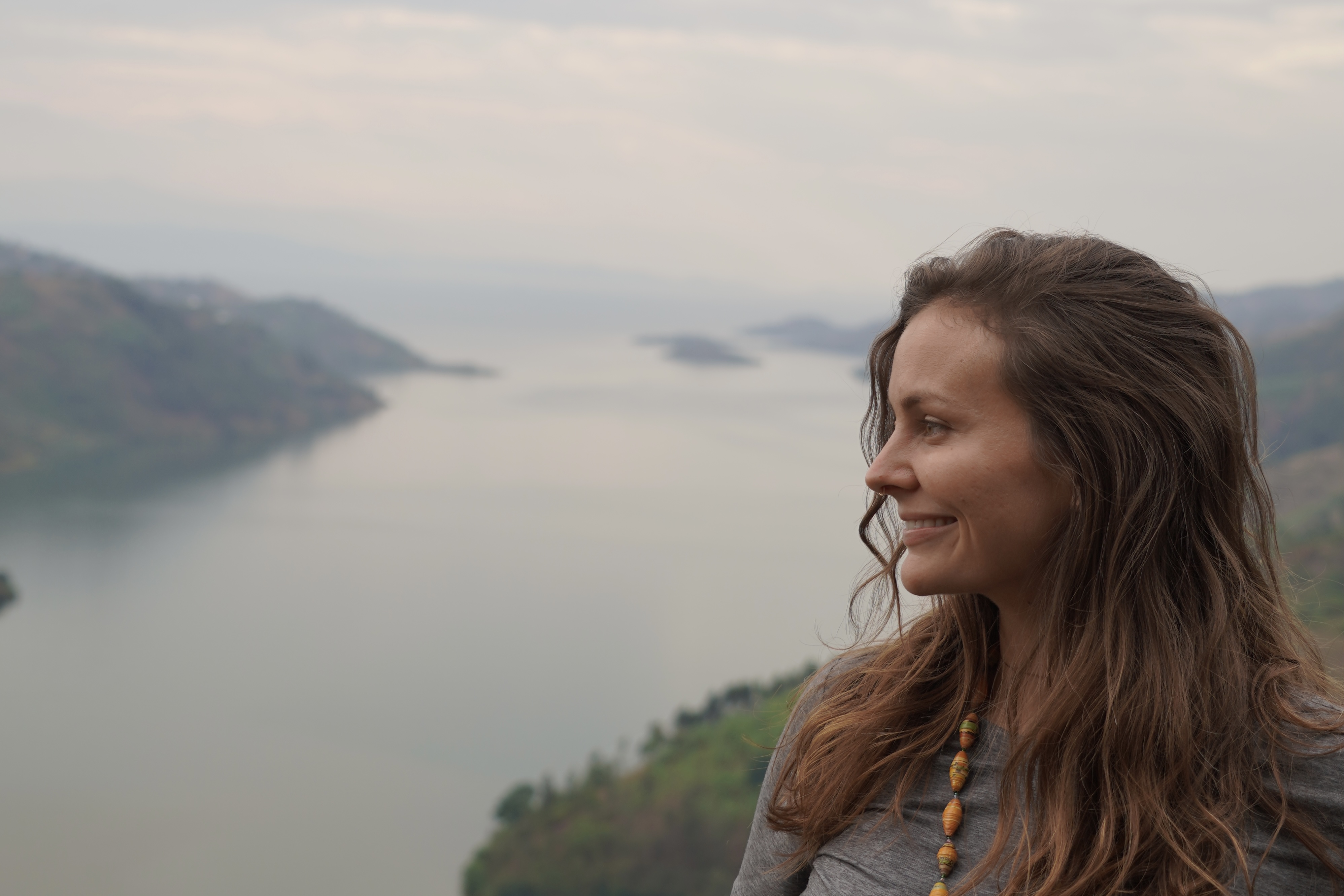
After flying over 20 hours to Kigali, I was grateful to receive my first, “you are very welcome here” from a smiling immigration officer. And I did feel welcome. My tour guide, Didier, said it again while opening the door to an army green safari car — my wifi-equipped chariot for the next 11 days.
If you’re familiar with operating 4WD cars in African countries (like my editor Steve on his legendary road trip across Uganda, Kenya, Tanzania, and Mozambique), you can rent a car in Kigali and tour the country yourself for about $50 a day. But in my experience, having a certified driver/tour guide was invaluable. Didier seamlessly answered every question thrown at him while adjusting the wifi router, taking charge of winding cliff-side roads, and playing the most vibey hiphop/R&B playlist of all time (along with some tracks he loved that were new to me).
Not to mention, getting picked up from the airport in a safari car is pretty sweet. This list compiles all the certified guides and tour groups through Rwanda Tours and Travel Association.
Rwandan Food
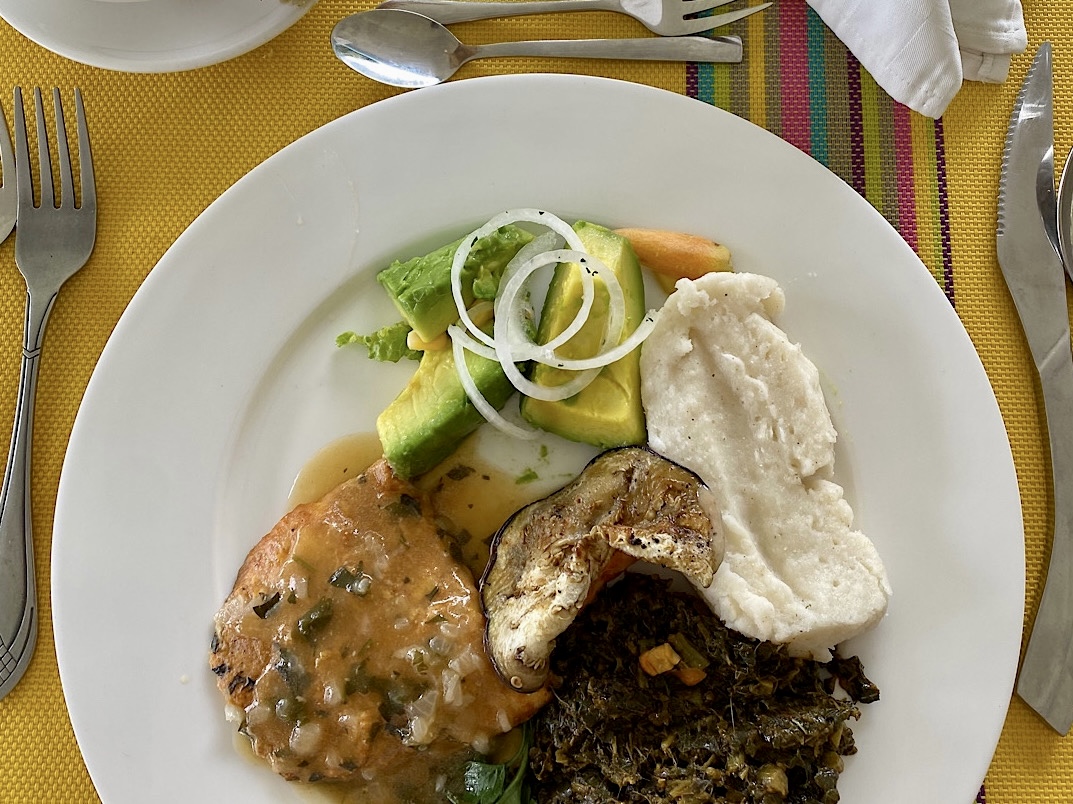
In all honesty, my time in Rwanda was hyper-focused on nature exploration. I ate a lot of boxed lunches in the car. Glamorous, I know. Still, I was able to try some insanely good traditional Rwandan cuisine during many hotel buffet dinners.
Some favorites:
- Igisafuria (a hearty meat and veggie stew).
- Mizuzu (fried plantain).
- Stewed beans.
- Isombe (stewed cassava leaves almost like sauteed spinach)
- Grilled tilapia.
- Sambaza (the surprisingly delicious tiny fried fish of Lake Kivu).
- And, of course, chapati (a soft pita-like bread).
You can’t find a bad cup of coffee in Rwanda, and Urwagwa, the nation’s famous banana beer, is a must-try. Sorry in advance because you will love banana beer but will be hard-pressed to find it anywhere else. Tropical fruits like tree tomato, avocado, and purple passion fruit are plentiful, and local yogurt, cheeses, and meats are divine.
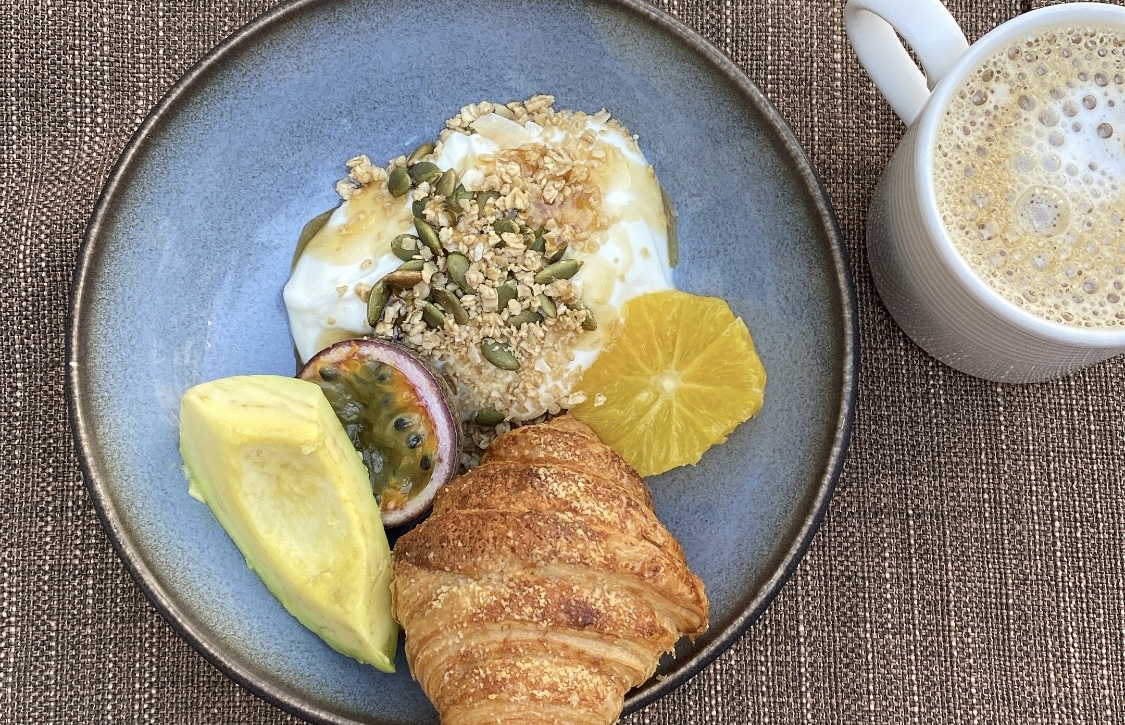
The capital city, Kigali, has the widest selection of restaurants by a long shot. My Kigali native friend and Youtuber Chey (cheymuv) nominates the family-owned Repub Lounge as her favorite spot for dinner in Kigali. Over at @checkoutrwanda, my buddy Freddie recommends hitting Biryogo car-free zone for classic Rwandan street food bites.
You can also check out this website for some of the best restaurants in the city. If you’re looking to party, Kigali also has a booming nightlife scene.
PART II — The Capital: Kigali
View this post on Instagram
On the way to my hotel on night one, I was shaken by viewing Kigali’s city streets. There was zero trash. Like none… I’m sorry, but LA, SF, and NYC could never!
Rwanda is the first nation I’ve been to with a ban on plastic bags. And there’s no other country in the world with a monthly community clean-up day. It’s no surprise that Kigali holds the title of Africa’s cleanest city.
Kigali Genocide Memorial
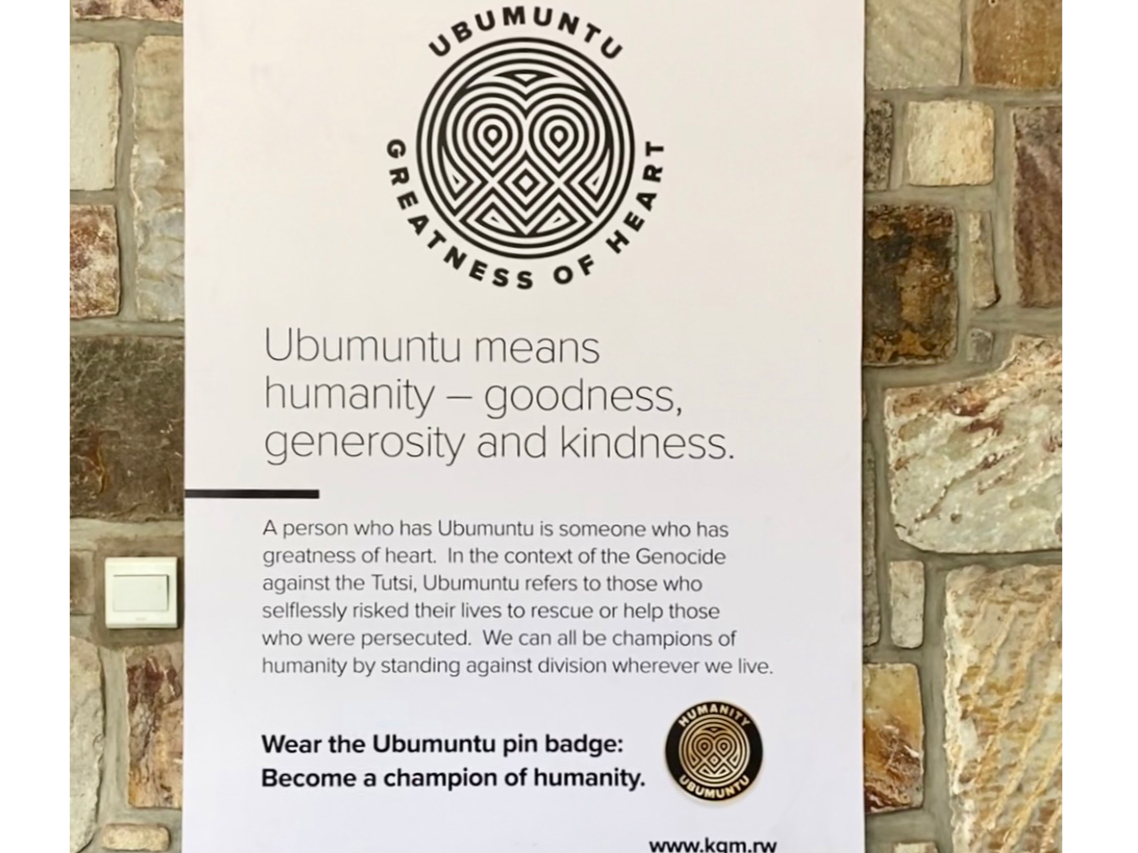
If you’ve got just a day or two in Kigali like I did, there’s only one imperative “to-do” — visit the Kigali Genocide Memorial. Familiarizing myself with the history of Rwanda’s tragic 1994 genocide felt important as a foreign traveler. It helped expand my understanding of the turn-around the country has made and better grasp the resilience of the Rwandan people.
The Genocide Memorial is a place to pay respect and learn. Entry is free, though there is a suggested donation of $20. I purchased a “Ubumuntu” (“to be human” in Kinyarwanda) pin in the gift shop as part of my donation. If you’ve got more time in the capital, check out:
- Nyandungu Eco-Park: Birdwatch, meander walking paths, or bike around this pristine nature reserve in the heart of the city.
- Rwanda Art Museum: Get a sense of Rwanda’s culture through its art, from past to present.
- Inema Arts Center: This art center offers dance classes! Rwanda’s traditional dance is very unique and captivating to watch.
- Caplaki Craft Village: This market can be a bit hectic, but it’s the best place to buy handmade artisanal crafts and souvenirs.
- Niyo Art Gallery & Café: A vibey gallery to hang out in and appreciate works of art made by locals.
- Kimironko Market: Local markets are always a great peek into local life.
- Rwanda Clothing: Handmade, custom-tailored threads made in Kigali.
Where to Stay in Kigali
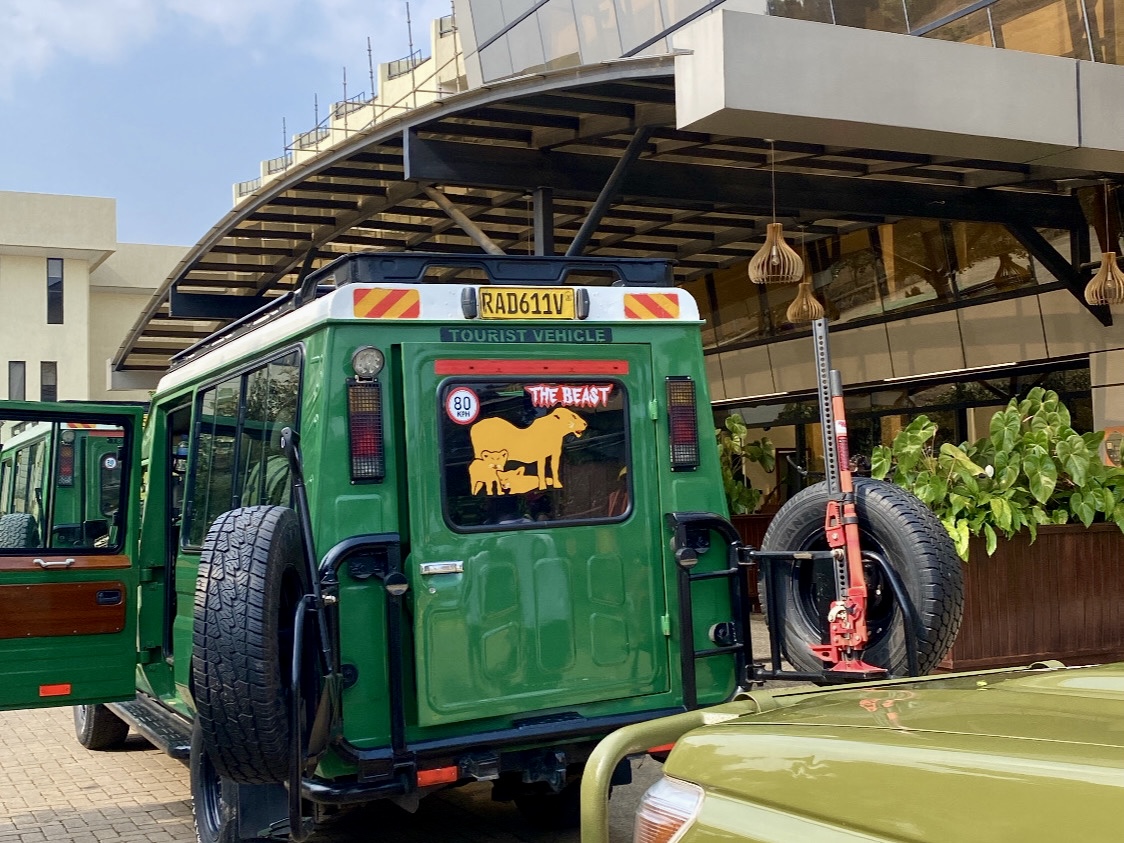
The Radisson Blu Kigali (like all Radisson Blus) is a modern and reliable stay. You can count on your room to have the non-negotiable amenities you’ll need after a 20+ hour flight: slippers, a waffle robe, and room service. I don’t blame you for ordering some American comfort food at 11 pm, I know I did. Nothing quite hits the spot like chicken and mashed potatoes after flying.
My room also had an unbeatable view of the Kigali Convention Center, which comes aglow each night in colorful lights to represent the Rwandan Peace Basket.
The Kigali Serena Hotel was a fabulous stay as well and had a fun tropical vibe to it. Both hotels have a gym and spa, a pool with plenty of chairs to lounge on (though I preferred the pool at Serena), on-site restaurants, and outstanding breakfast spreads. Nightly rates start at $200 for each.
PART III — Nyungwe National Park
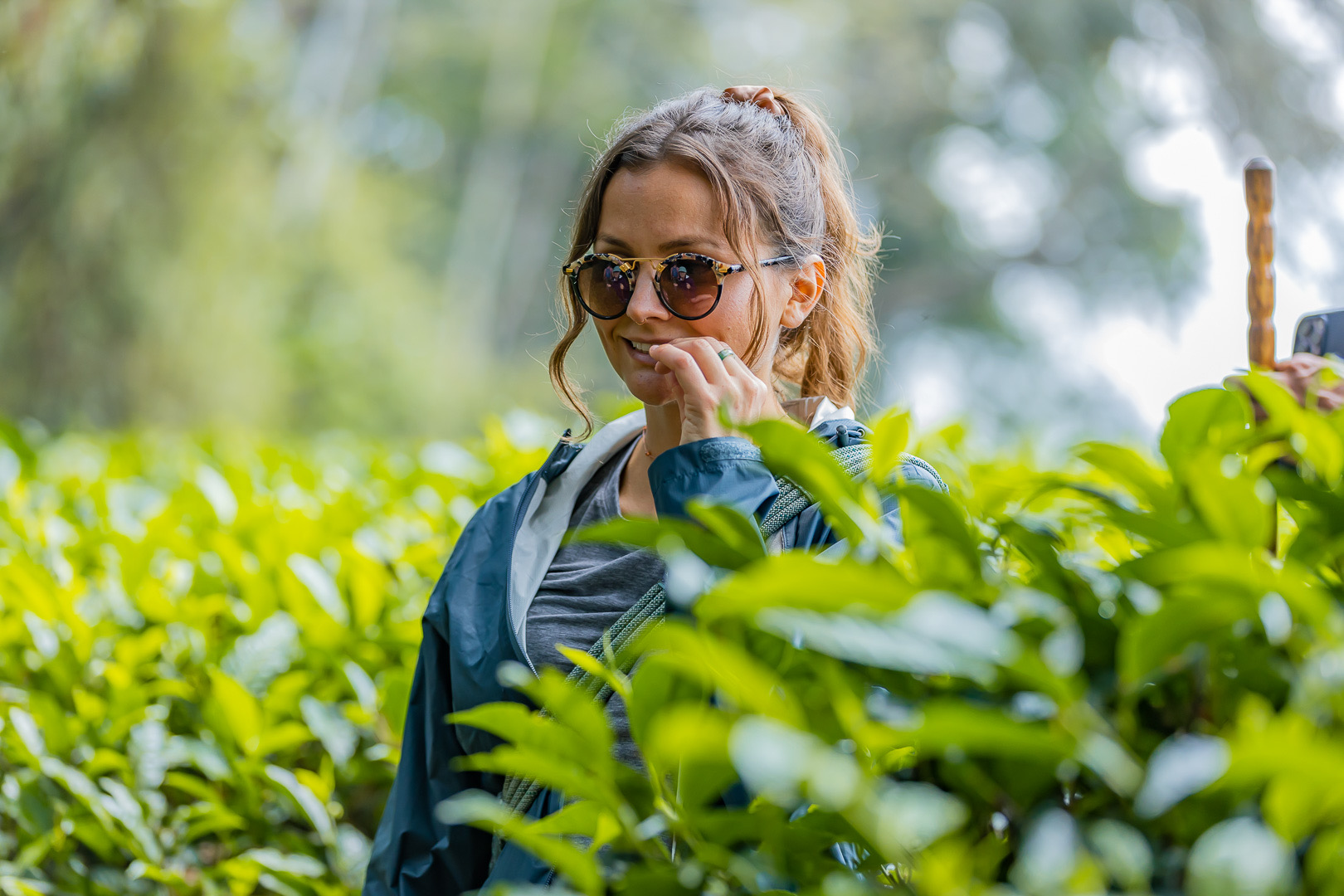
Despite hiking just three of the park’s 15 trails, I witnessed some of the most inspiring nature scenes of my life in Nyungwe National Park. This is the largest expanse of forest in the country, and just this year became UNESCO-protected. To get there from Kigali, you’re in for a four-and-a-half-hour drive…
Let it set the stage for a number of long drives in Rwanda! But I promise your eyes will be glued out the window the whole time…

Southwestern Rwanda’s hillsides are patterned with rice farms and rolling green tea plantations. You’re about to step foot in one of Africa’s oldest rainforests! I spent just two days in Nyungwe, but you could easily spend three or more. The Nyungwe National Park entry fee is $100. Please make your National Park entry reservations and primate trekking permits in advance, friends.
TIP: Chimpanzee trekking at Nyungwe is a great alternative to gorilla trekking if you’re trying to save some cash.
Ndambarare Waterfall
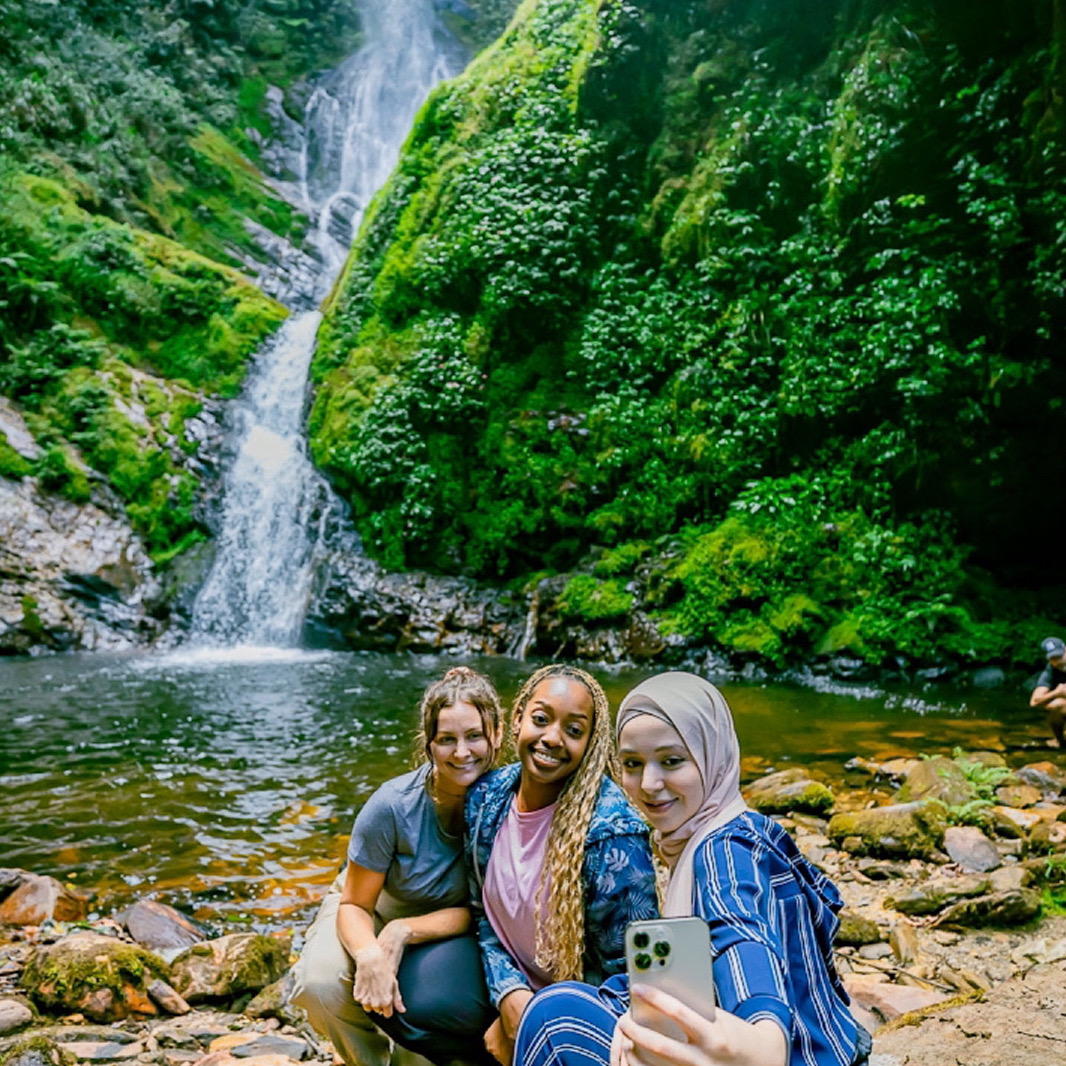
The trek to Ndambarare Waterfall was gorgeous. The first bit is through tea estate pathways, where colobus monkeys hide out and peer down at you from the trees above. From flat grasslands begins the slow descent into the jungle, where thick, moss-covered vines hang overhead. You’ll know you’re getting close the more humid it gets. After about an hour and a half of hiking, the Ndambarare Waterfall welcomed us with a cool, shimmering mist.
I spent time taking in the peaceful atmosphere and snapping photos of the gushing 50-foot falls. There’s a freshwater spring in the rock alongside the waterfall where I (somewhat hesitantly) drank the purest water of my life. It was a surreal experience.
The Ndambarare Waterfall hike is $55 and includes a guide. You can book the 1 pm like me or the 9 am, for which you’ll need to leave Kigali early (like 4:30 am).
Gisakura Tea Estate
View this post on Instagram
Returning from the Ndambarare Waterfall hike led us back through the Gisakura Tea Estate, where a group of young women in colorful Kitenge dresses were harvesting tea leaves. One of the women, Jenny, signaled for me to join her in the sea of green. She fastened a traditional woven basket around my waist then showed me which leaves were ripe for harvest, then how to toss them into the basket for safekeeping.
This experience with Jenny (pictured above) is one of my most cherished memories in Rwanda! Be sure to give a tip after taking photos or joining them in the harvest.
IVOMO Tea Experience
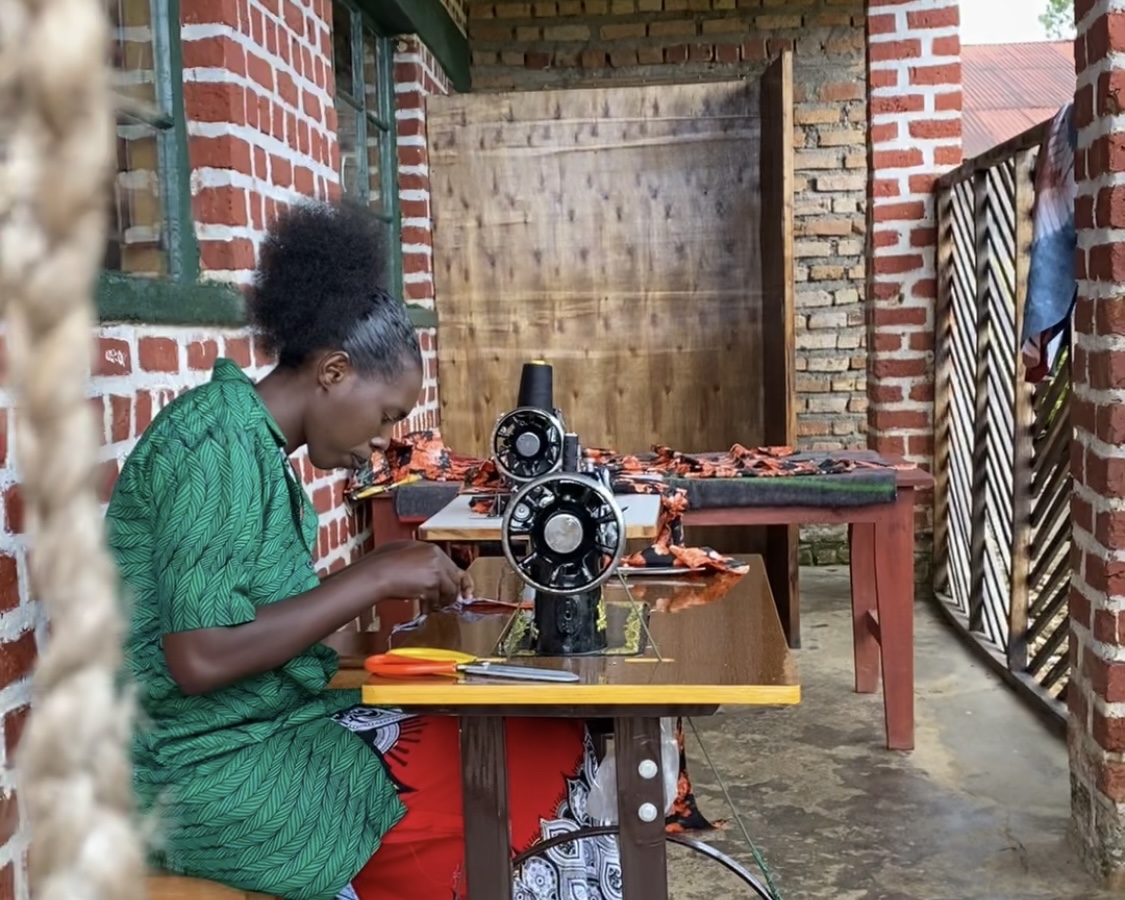
Near the exit of the park is the IVOMO mini museum and storefront. This social enterprise creates jobs for local women and helps provide clean drinking water to surrounding communities, among other hugely important objectives. Pop in to support and learn about the history of tea in Rwanda with Rick. Various tea experiences are offered at IVOMO starting at $30. Don’t leave without buying some Rwandan green or black tea, an African paper bead necklace, or a headband or cinch bag sewn from traditional textiles.
All the goodies here are crafted by local women from the community!
Canopy Walkway
View this post on Instagram
While you’re in Nyungwe National Park, I highly recommend doing the Canopy Walkway. This narrow aerial bridge rises some 200 feet above the forest floor, which my guide said contains remnants from the age of dinosaurs! Crossing the second expanse of the three-part bridge, a brilliant sunset in the east while red-tailed monkeys swung from the trees alongside.
The vista was mind-blowing. Unless you’re afraid of heights, this is a must-do while in Rwanda. The Canopy Walkway hike is offered at $60 per person and includes a guide. The first tour begins at 9 am, but I suggest taking the last at 3 pm and trying to catch the sunset from the bridge.
Where to Stay Near Nyungwe National Park
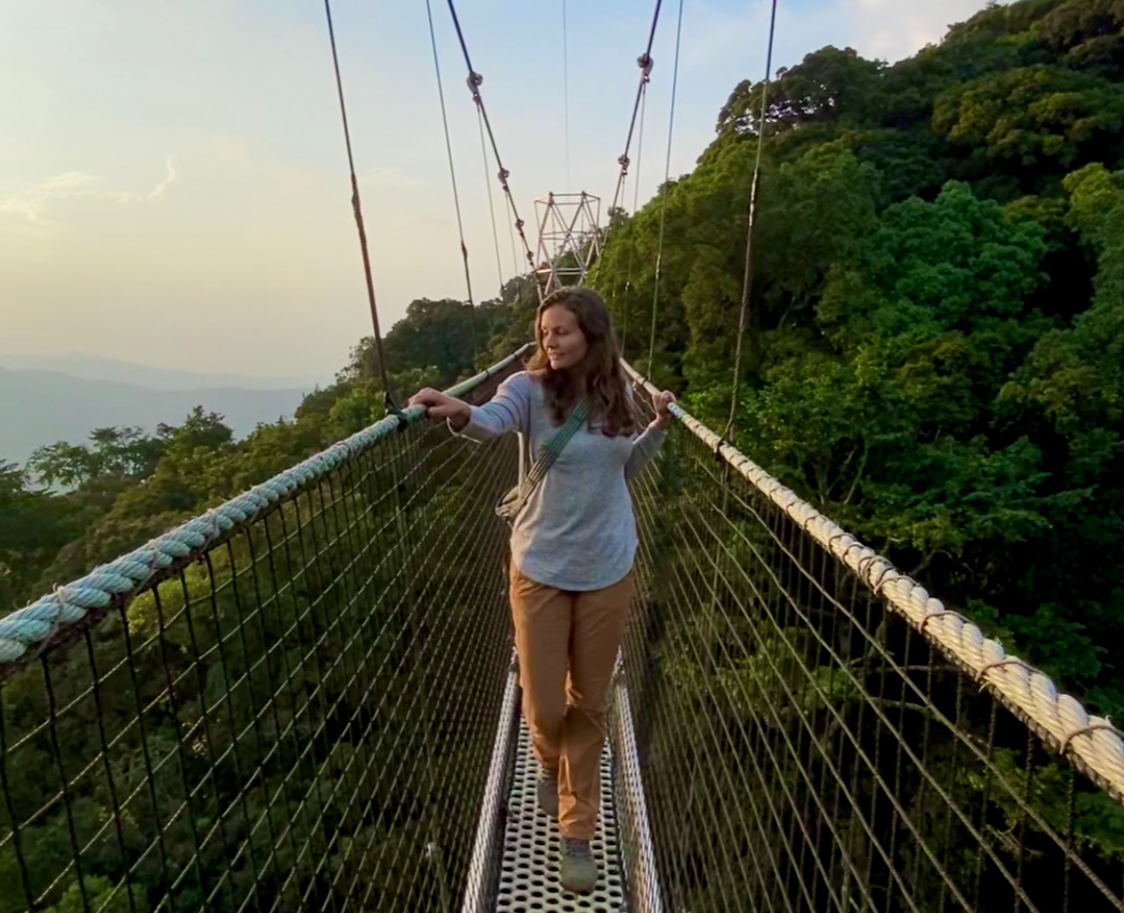
If you plan on bouncing between Nyungwe National Park and Lake Kivu, the Mantis Kivu Marina Bay Hotel ($145) is a great lodging option. Every single room has a balcony with a view of the surrounding area, the perfect place to savor morning coffee before a big day. If you have any free time (I was hard-pressed to find much, there’s so much to see in Rwanda!) spend it relaxing by the pool.
If you have the budget (or lack thereof) book a stay at One&Only Nyungwe House, set right on a tea plantation. One&Only has two locations in Rwanda, and from the looks of the infinity edge pool, tea lounge, and forest spa… One & Only Nyungwe House is worth every penny (starting at $1,600 per night). For a budget-friendly option, the Nyungwe Nziza Ecolodge has quaint tea-view cabins for $65 a night!
PART IV — Lake Kivu
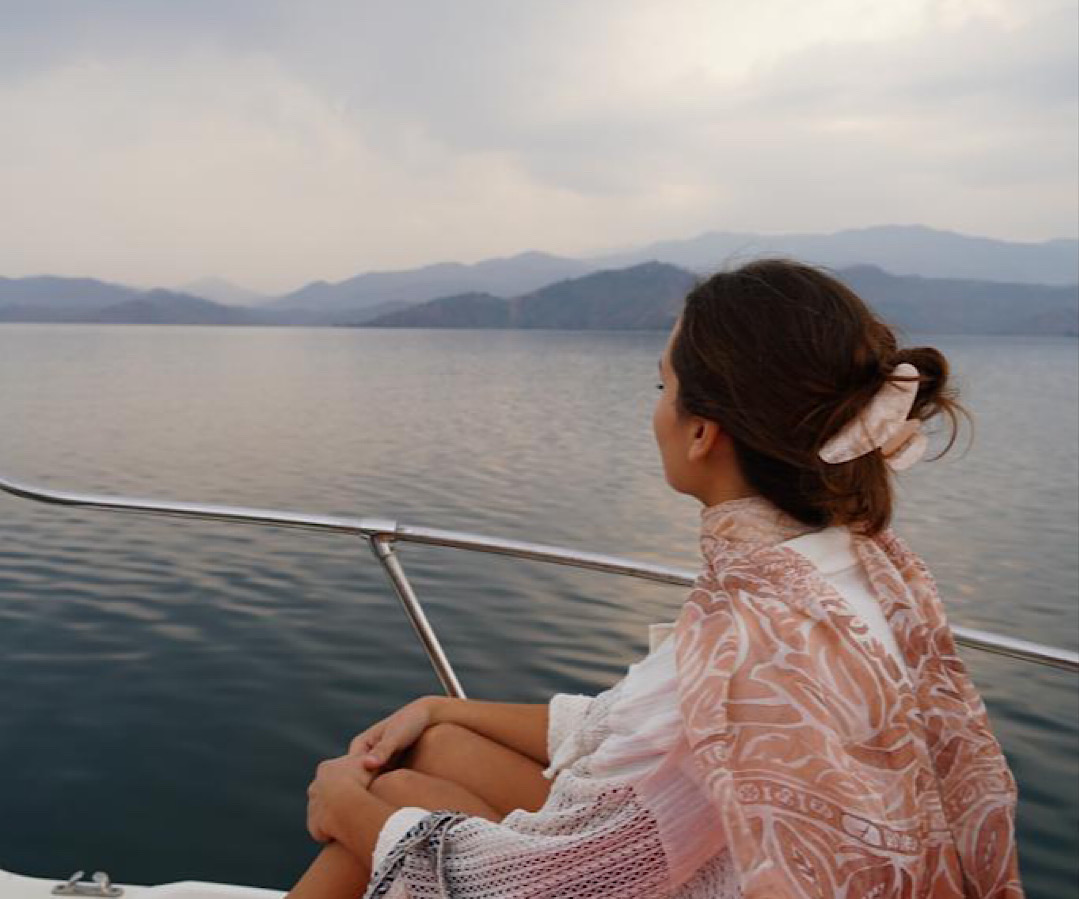
Rwanda is home to one of Africa’s seven Great Lakes: the massive Lake Kivu. Lake Kivu stretches over 1,000 square miles and is divided between Rwanda and the DRC. I insist you spend at least one day getting to know the lake — which, by the way, has no hippos or crocodiles!
There’s truly something magical about Lake Kivu. But there’s also something downright spooky about it, too. Bubbling beneath the depths of Lake Kivu is a toxic concoction of gasses that could cause a large limbic explosion (basically a big champagne pop) in the case of powerful seismic or volcanic activity. But fear not! Just don’t venture into the center of the lake, which is easy since the lake looks about as large as the ocean!
Boat Tour on Lake Kivu
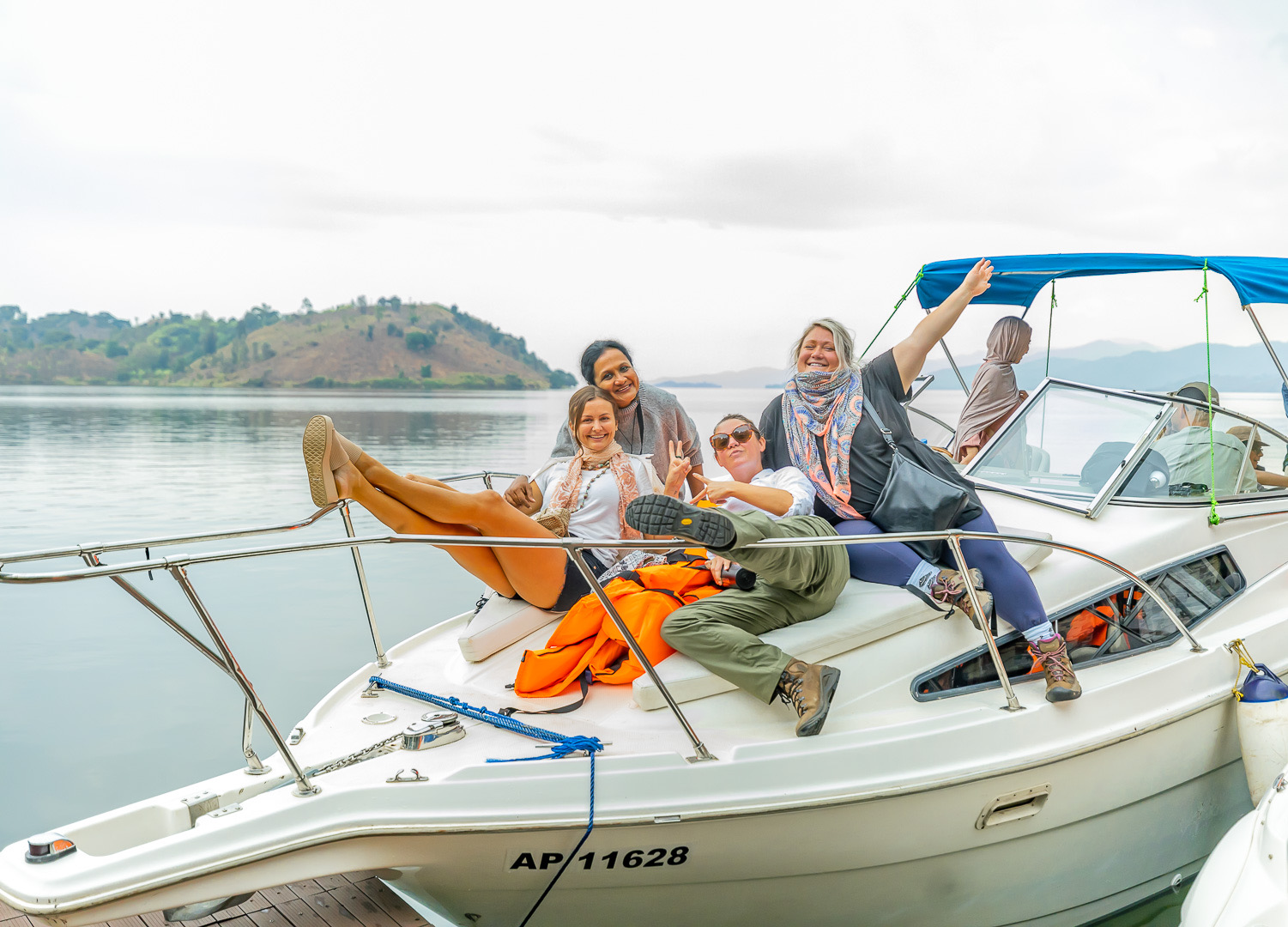
Boat along Lake Kivu’s glassy surface, see the famous swimming cows and peer out beyond the layers of smoky-colored hills in the distance. A boat ride on Lake Kivu is not just relaxing, it’s a great way to travel to your next hotel along the lake! You can book a Lake Kivu boat tour through your hotel, or choose a tour operator here.
If weather permits (unfortunately it didn’t for me), definitely opt for a kayak excursion on the lake!
Kinunu Wonders Coffee Tour
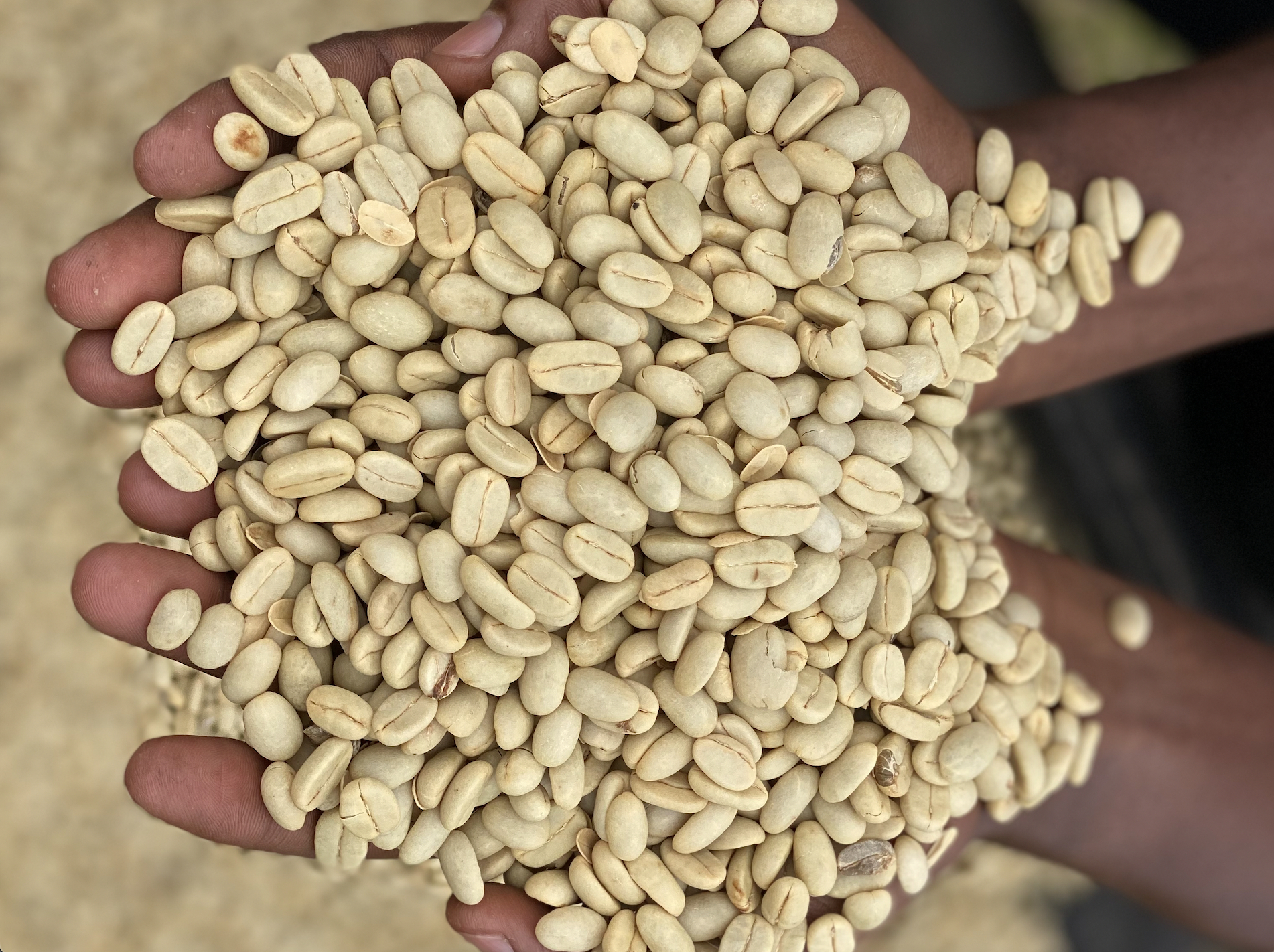
Rwanda has almost half a million small coffee farms, making it the the 9th largest producer of arabica coffee in Africa! One morning on Lake Kivu, I set out by boat to Kinunu Wonders, producer of “Boneza” coffee. As the boat puttered up to shore, the tranquil charm and brilliant fragrance of coffee blooms awoken my senses. The tour was highly insightful and enjoyable. This particular plantation is home to an original manual washing station, a processing room, and a small guest house. At the end of the tour, you’ll sample the coffee and have the opportunity to take some home with you – do!
Your loved ones will thank you for bringing them a taste of Rwanda.
Where to Stay on Lake Kivu
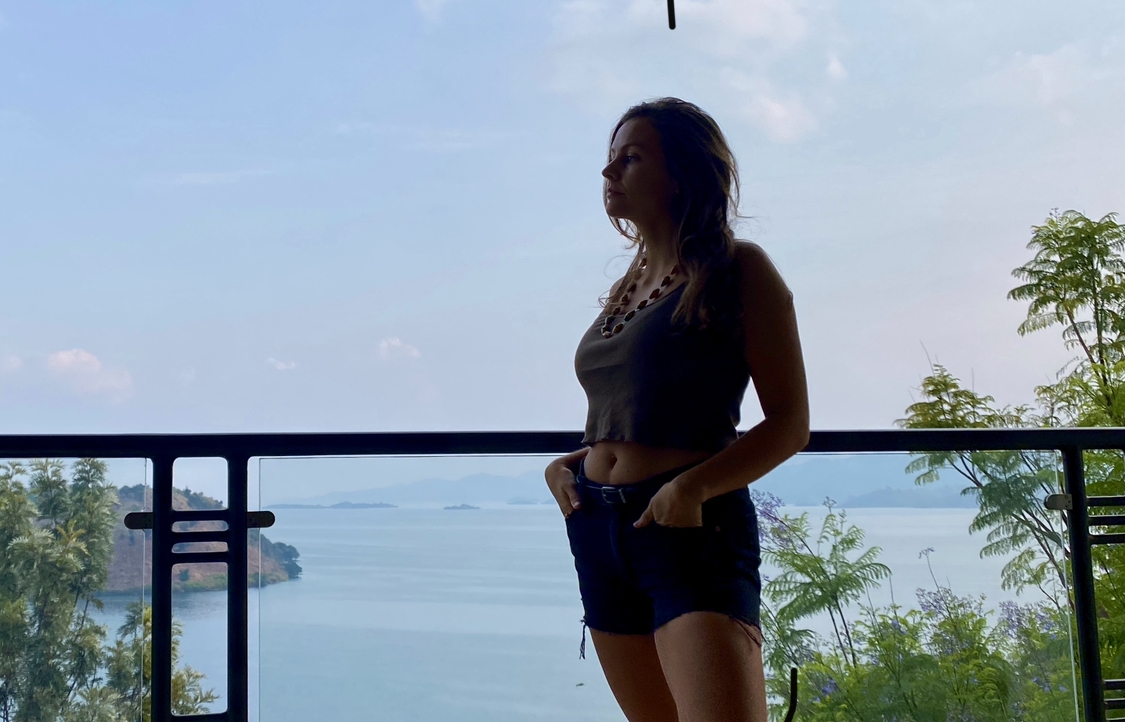
The southernmost hotel I stayed in on Lake Kivu was the aforementioned Mantis Kivu Marina Bay Hotel, moving north along Lake Kivu, I stayed in a different hotel each night. The stunning Cleo Lake Kivu in Kibuye was the most elegant of my stays in Rwanda. To my suprise, I was randomly given a villa, which knocked my socks off, but all the rooms (starting around $350 a night) have inane lake views.
Night two on Lake Kivu was at the ’90s style Lake Kivu Serena Hotel in Rubavu (previously known as Gisenyi) on Lake Kivu’s northern shore.

Playing cards with the girls while sipping “Kivu Sours” on the cushioned lounge chairs by the lake was so fun. And I found Serena Hotel’s food to be better than Cleo’s!
Rates for Serena Hotel start at $190 a night. If you liked the tranquility of Kinunu Wonders, they have charming guest rooms for rent at a super reasonable $30 a night. Near Kinunu Wonders in Boneza, I had a fabulous lakeside lunch at a beachfront bed and breakfast, Rushel Kivu Lodge. After chilling on the property, watching people play volleyball on the sand, and walking the shoreline, I would recommend a stay there wholeheartedly.
Prices are around $130-180 a night.
PART V — Volcanoes National Park

Just one hour north of Lake Kivu lies Volcanoes National Park is Rwanda’s section of the Virunga Mountain range. The Virunga Mountains are a chain of eight volcanoes bordering Rwanda, the DRC, and Uganda. Living in this UNESCO-protected biosphere is most of the remaining population of mountain gorillas on the planet!
Since Rwanda’s Volcanoes National Park contains five of Virunga’s volcanoes and over one-third of these impressive primates — gorilla trekking remains the pièce de résistance for many travelers in the “Land of a Thousand Hills.” It’s also a conservation success story leading the way in sustainable eco and wildlife tourism.
Gorilla Tracking
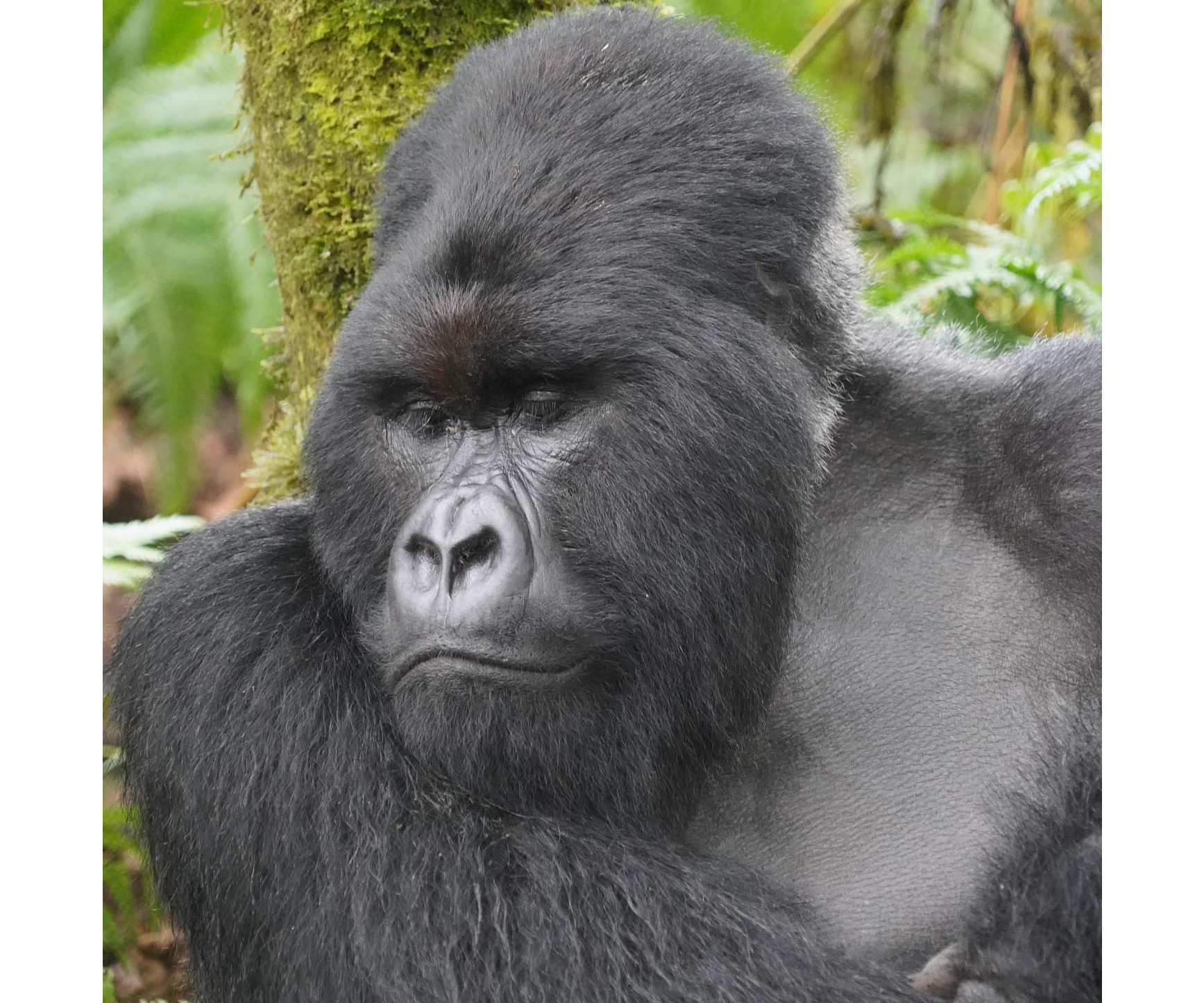
Anticipation rose as temperatures dropped the higher we climbed on the slope of Mount Bisoke. We began in the village below, where I coupled with a porter and was given a wooden walking stick. We then started up the zigzag path toward the base of the mountain, passing family farms and homes where white goats manicured surrounding grass and local children yelled: “hello!” to which we yelled back “muraho!” (hello in Kinyarwanda).
A small set of stairs some 45 minutes up marked the entrance to the national park.
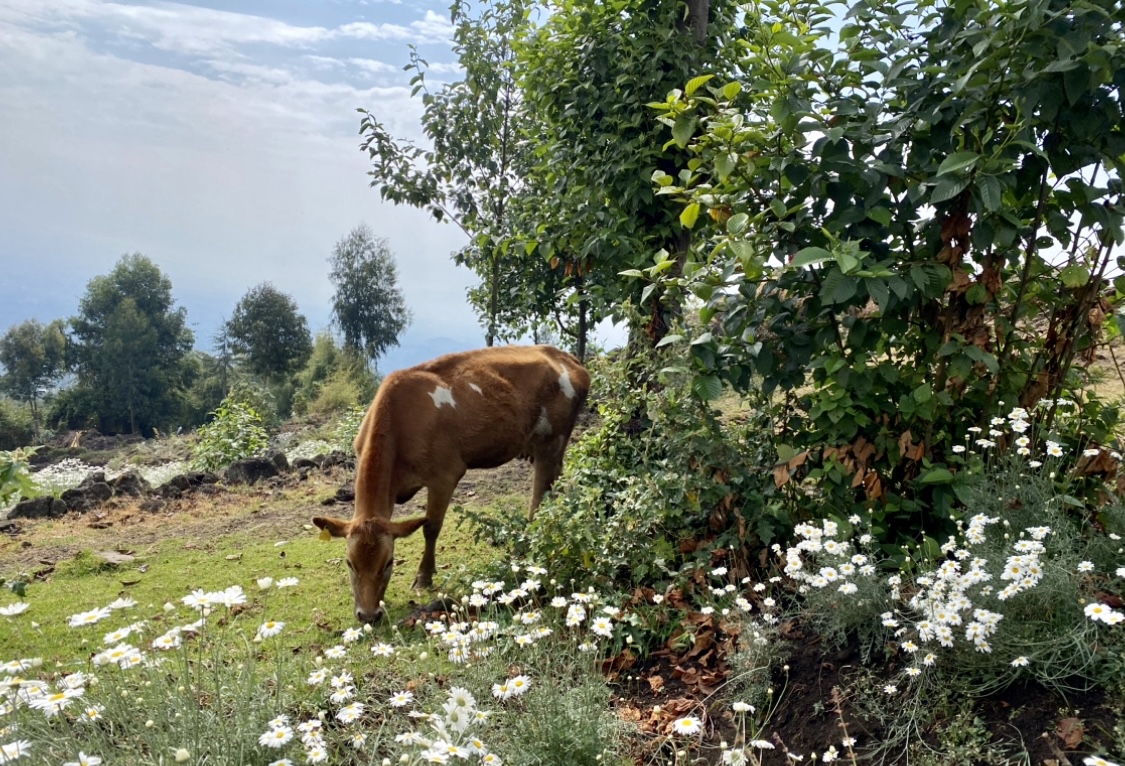
We huddled up to go over expectations, “friendly grunts,” and gorilla do’s (slow movement) and don’ts (camera flash, intimidating eye contact). Over two hours we climbed a rainforest floor piled in fallen foliage, layered in endless root systems. The trees towered higher than any I’d ever seen, and the worms were the size of snakes.
Finally, the moment came: our tracker confirmed the Susa gorilla family was nearby. My nerves surged and morphed into excitement. There’s nothing with which I can compare the sensation of peering into the eyes of a gorilla; seeing a mother shield her baby from rain under the cover of her thick black hair; or watching a teenage gorilla peel back sticks like string cheese.
It was an hour I will never forget.
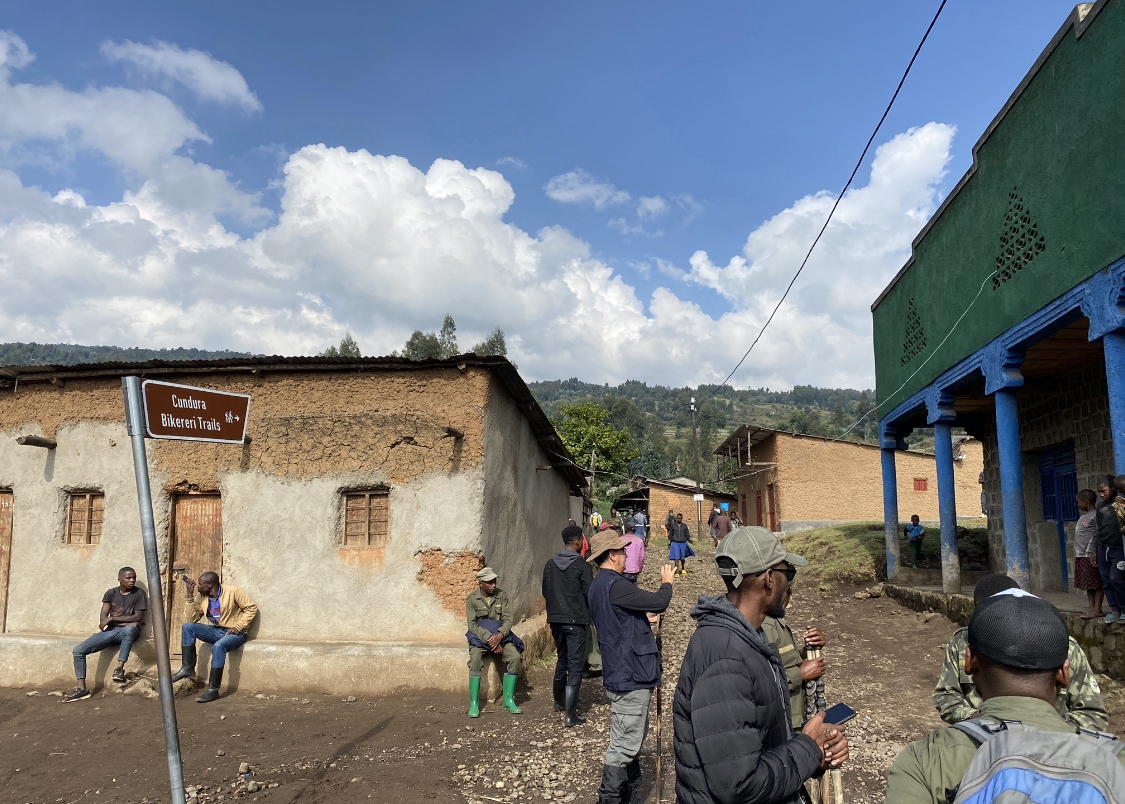
You can apply for the gorilla trekking permit here. Some quick facts about gorilla tracking in Volcanoes National Park:
- There are 12 gorilla families all living in different parts of the park
- Which family you trek to depends on your desired hike intensity (I chose a higher level of intensity, but would’ve been keen on having an easier hike should there be a next time)
- There are 96 permits per day, each costing $1,500
- Each group is eight people at most
- The gorilla families will see one group of humans for just one hour per day
- The gorillas are monitored for safety and health by trackers almost around the clock
- Much of the trekking permit funds are allocated to conservation and park maintenance
- You will wear a face mask for the safety of you and the gorillas (mostly the gorillas, who are susceptible to human illness)
Gorilla Guardians Cultural Village
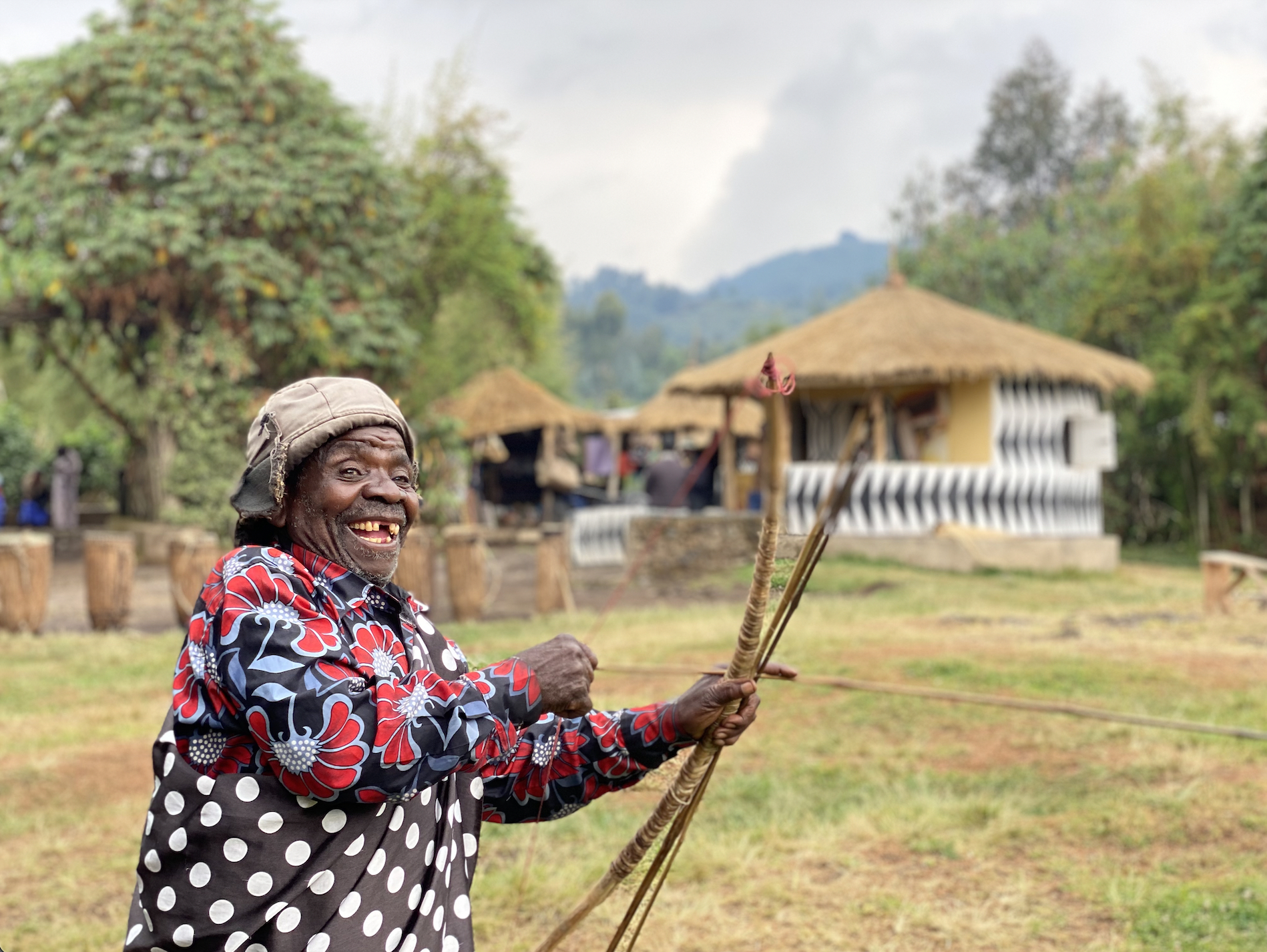
In nearby Musanze, this non-profit creates cultural tourism jobs to former gorilla poachers, who once played a major role in the decimation of Rwanda’s gorilla population. Walking into the Gorilla Guardians Cultural Village, I was welcomed by a circle of powerful drummers and Intore dancers wearing traditional Rwandan textiles.
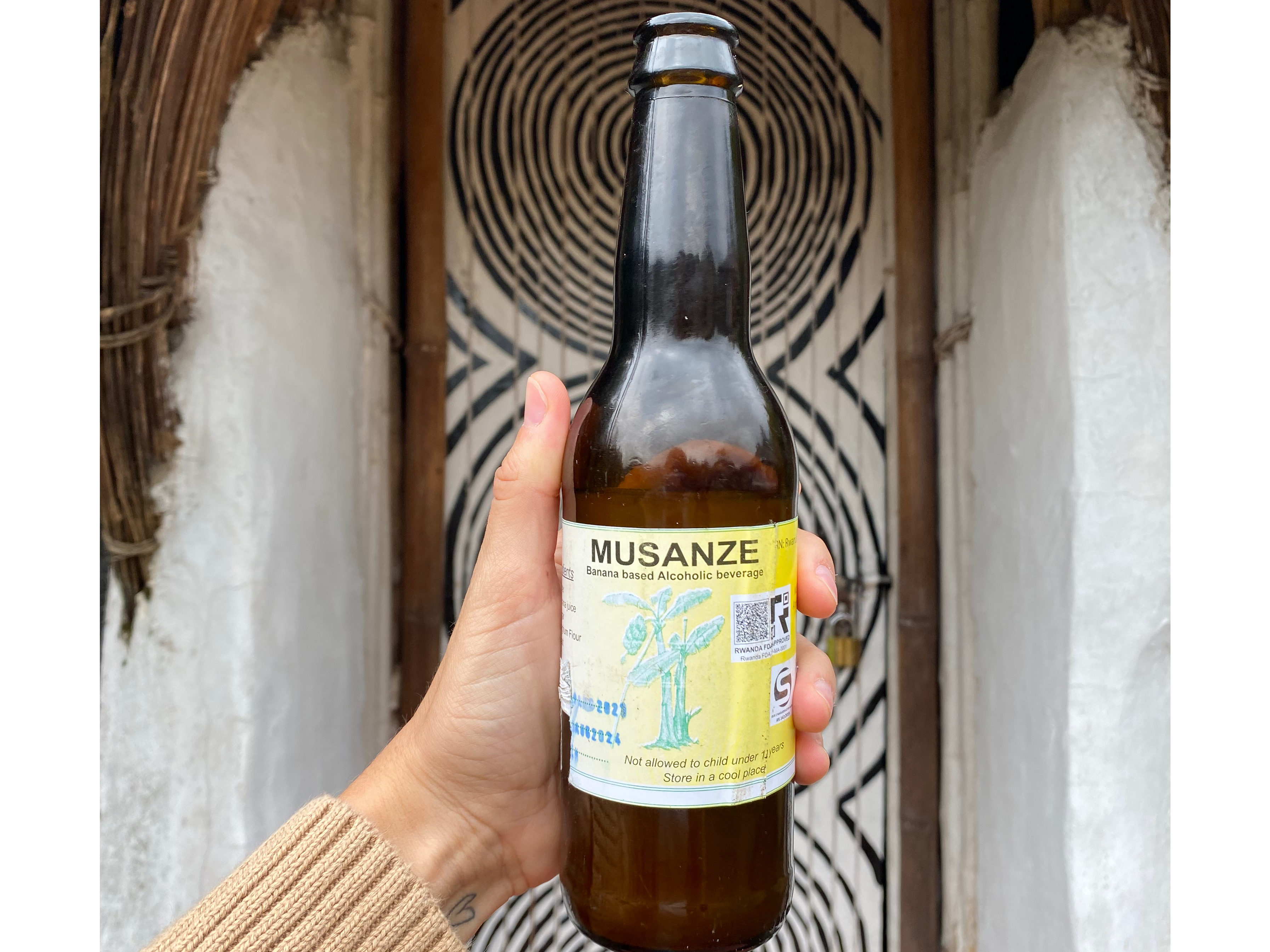
I shot a bow and arrow while learning about Rwanda’s archery and hunting heritage, visited the medicine man who treated me with some much-needed aloe vera, watched sorghum be ground into powder to create Rwanda’s famous Banana beer (yum!), and role-played a traditional wedding!
The donation for this experience is $20, and in my opinion, well worth it, especially considering the direct positive impact these tourism jobs have on the environment and local community.
Dian Fossey Museum
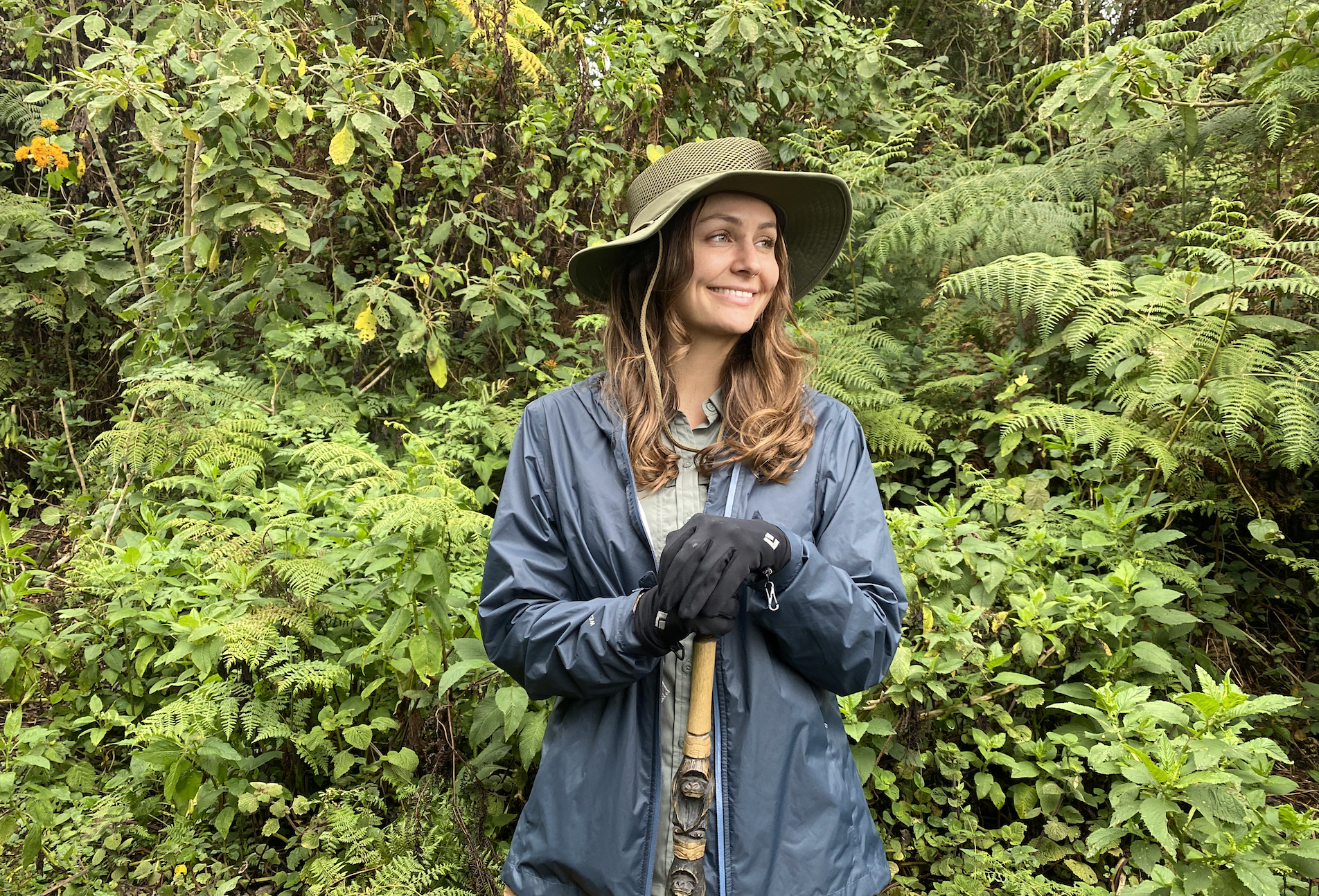
The journey of Rwanda’s commitment to gorilla conservation was sparked by the work of the late Dian Fossey, a San Francisco-born zoologist who spent 20 years living alongside the mountain gorillas in Volcanoes National Park. She is credited for bringing awareness and study to these impressive primates way back in the 1960’s! I highly recommend doing a tour at the Dian Fossey Museum while you’re in Volcanoes National Park.
The information is intriguing, but also, the experience is also interactive. You are suggested to contribute a $20 donation for entry.
Where to Stay in Volcanoes National Park
View this post on Instagram
Trust me when I say that you’re going to want a cushy place to land and a hot shower post-primate trek. For me, that haven was the Virunga Inn Resort & Spa, tucked beneath the volcano mountain slopes. Its modern cabins are immersed in nature and a haven to retreat back to ($763). Hit the small gym was for a quick morning workout and enjoy the on-site restaurant. I thought the food was delicious and the staff was super friendly. The Virunga Inn has gators for your gorilla trek outfit (sexy), and will take your hiking boots for a cleaning post-trek.
The best budget option is the peaceful Fravan Eco-Resort By Apogee, for around just $50 a night you’ll have close access to the Volcanoes Park Headquarters. The hotel of ultimate opulence? The One&Only Gorilla’s Nest ($3,700) or Bisate Lodge (starting at $1,930). Both have more amenities than you may need (the Gorilla’s Nest even has a helipad), plus some of the most sublime volcano views in the area.
PART VI — Akagera National Park
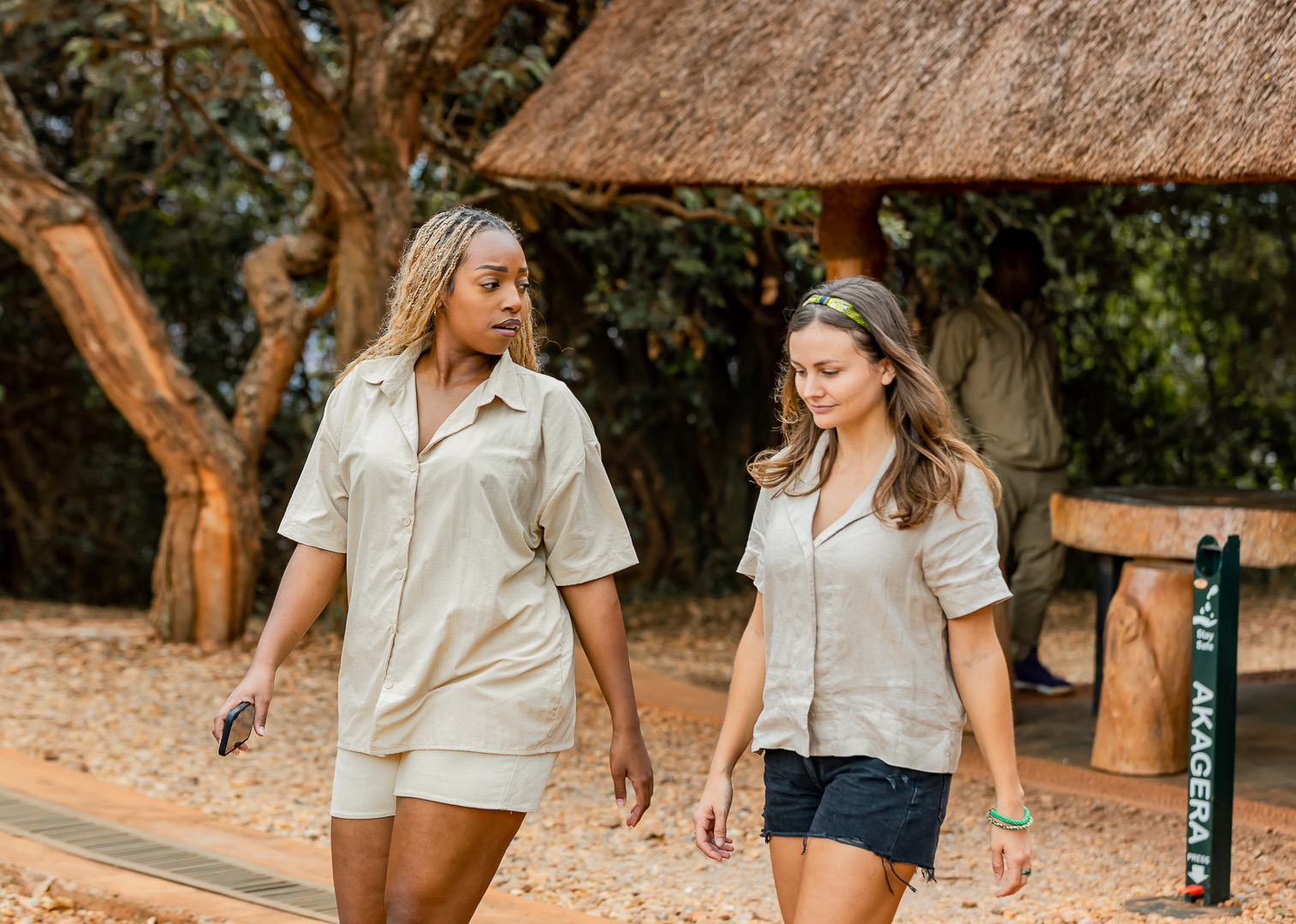
Eastern Rwanda’s Akagera National Park is Central Africa’s largest protected wetland, and the only “Big 5” park in Rwanda! You can even see Tanzania from the eastern edge of the park! The drive from Kigali is a quick 2.5 hours and a decent 5 hours from Kinigi (Volcanoes National Park area). But you’d be remiss not to have a safari at the top of your Rwanda itinerary!
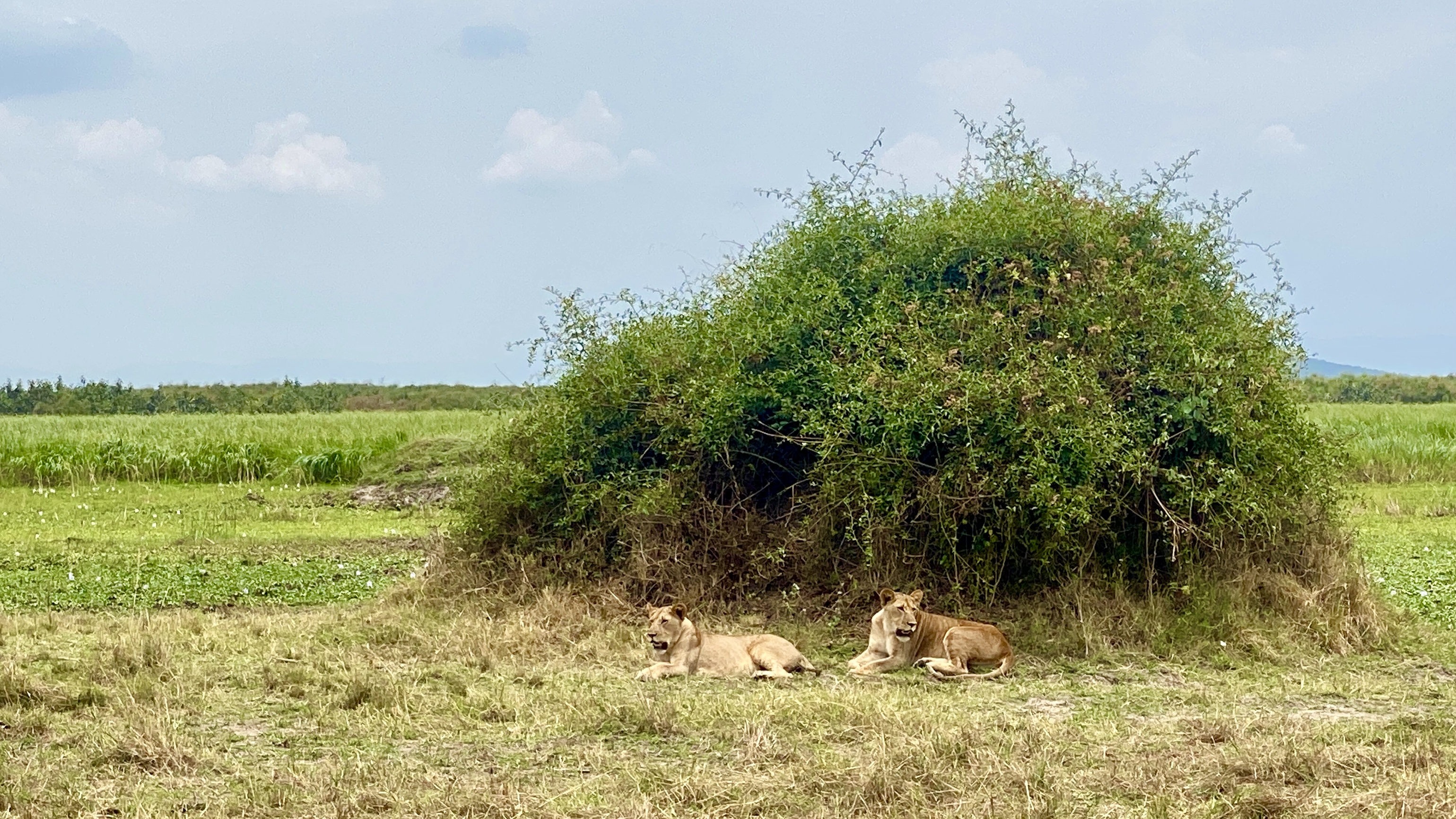
The park entry fee is $100 for international visitors and offers the options for a self-driven game drive for a $10 vehicle entry fee. You can also hire a driver for your car for $40 per day, or hire a car and driver for $280 full day, $180 half day. The boat safari is a great way to get out and see Rwanda’s Lake Ihema, rates are just $35 for a daytime trip and $45 for the sunset tour. You can pre-register for your safaris at this link.
Big 5 Game Drive
View this post on Instagram
I was honestly not prepared for the animals I saw during my safari at Akagera! From my cozy seat in the safari car, I saw hundreds of huge cape buffalo, dozens of cute-but-deadly hippos, many dazzles of zebra (yes, a group of zebras is called a dazzle!), tons of impala, and a handful of giraffes, lions, and elephants.
A dream come true for a girl who always wanted to be a zoologist when she was little.
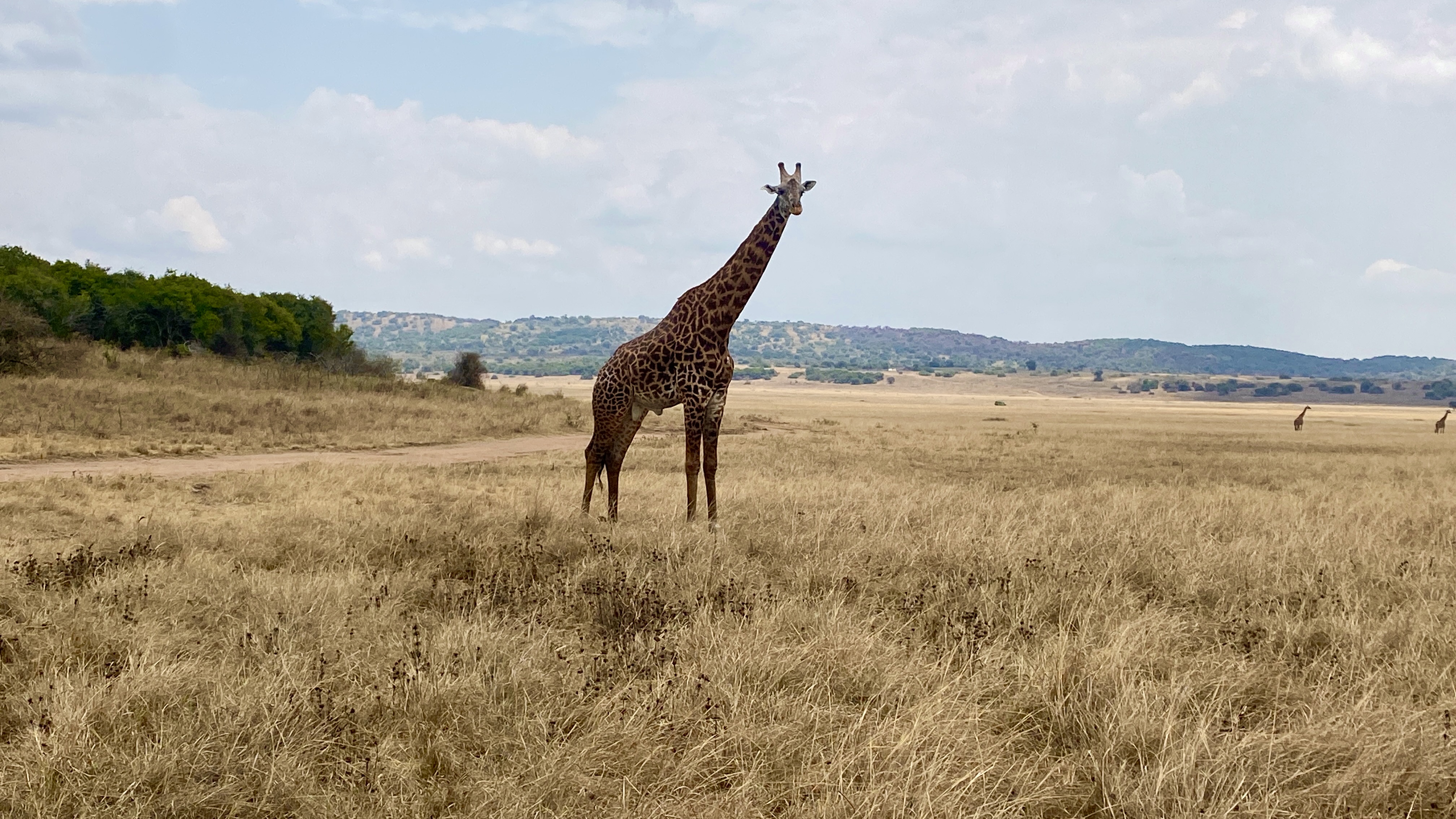
The game drive is long, like 4-5 hours, and gives you the chance to see many of Akagera’s 8,000 animals. Be sure to wear something comfy and pack extra batteries for your camera gear! You’ll need it. As with all national parks in Rwanda, 10% of profits go right back into supporting the animals, the integrity of the park, and the surrounding communities.
Boat Safari on Lake Ihema
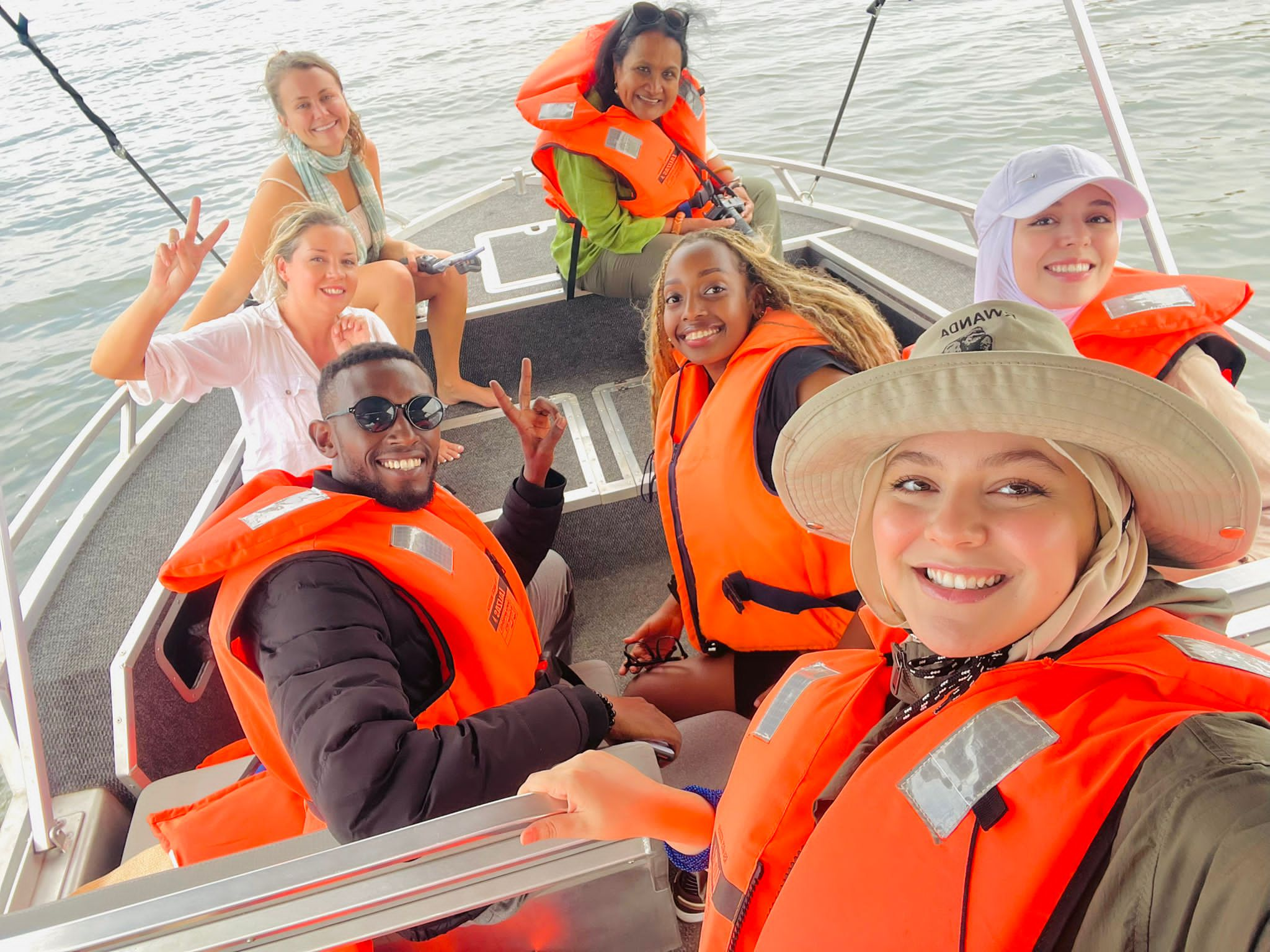
My afternoon boat safari experience was laid back and relaxed. That is, until, we budded right up to the edge of an island where a massive Cape Buffalo was taking a nap. Like literally 15ft from this massive, horned animal. But the tour guides know what they’re doing and just how to maneuver the boat to get you up close and personal.
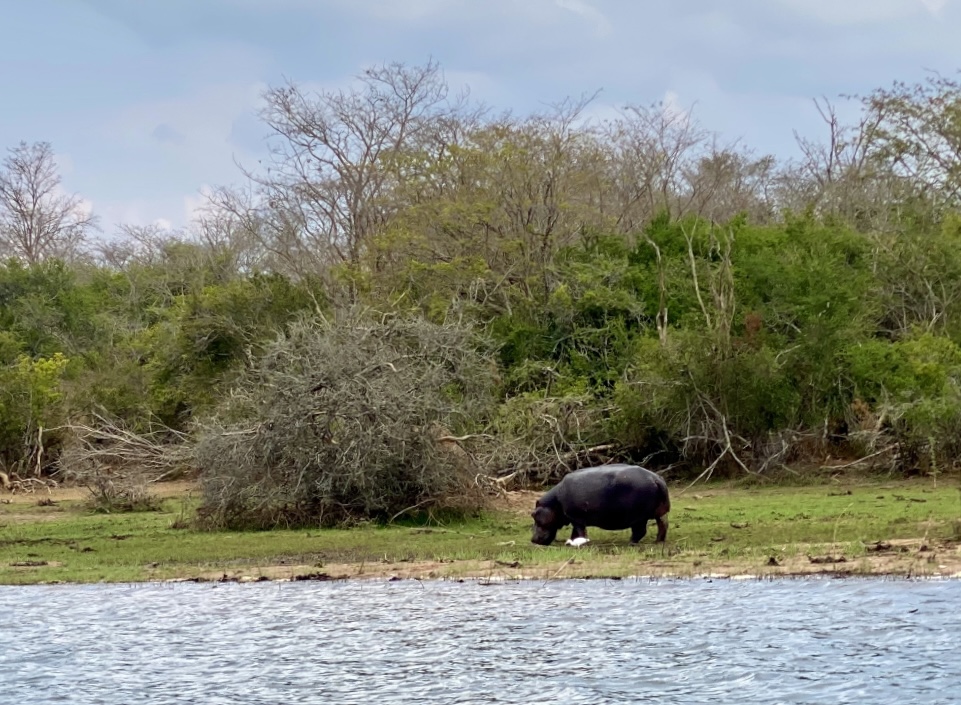
The boat safari is a quick hour or so and scoots around a few of the different islands in Lake Ihema in the southern part of Akagera National Park. There was no shortage of chonky hippos lazing in the water, a few rhinos walking the grassy areas, and many incredible bird species, including a Goliath heron. These beasts have a wingspan of 6-7.5 feet!
Where to Stay in Akagera National Park
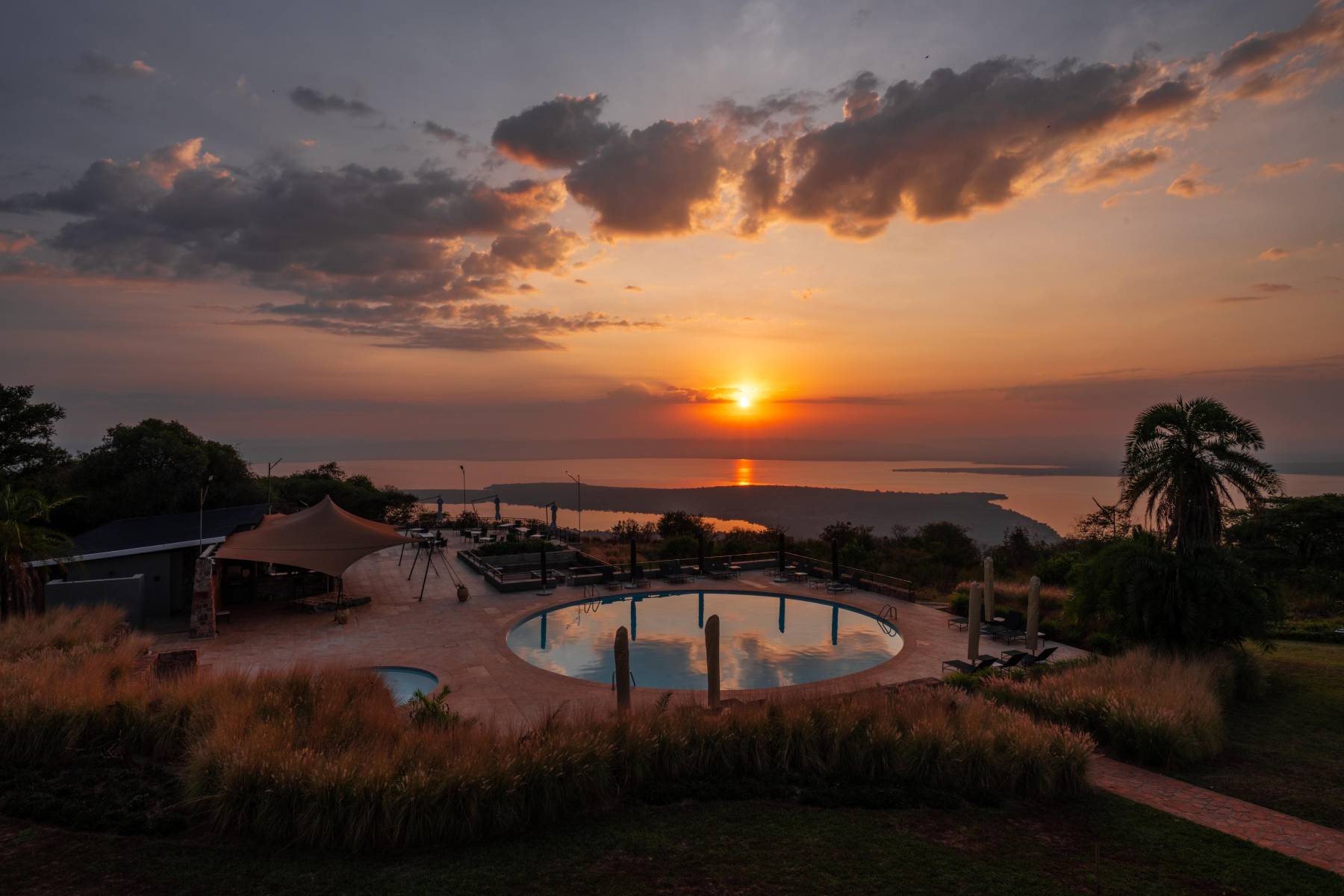
Mantis Akagera Game Lodge is the only luxury in-park lodging in Akagera National Park. It is 100% worth the price, which is a consistent $120-175 year round. The pool deck is the place to be, chilling with a drink in hand and conversing about your best animal sightings of the day. The rooms are spread out around the property, which is surrounded by gorgeous views of Akagera’s raw savannah.







